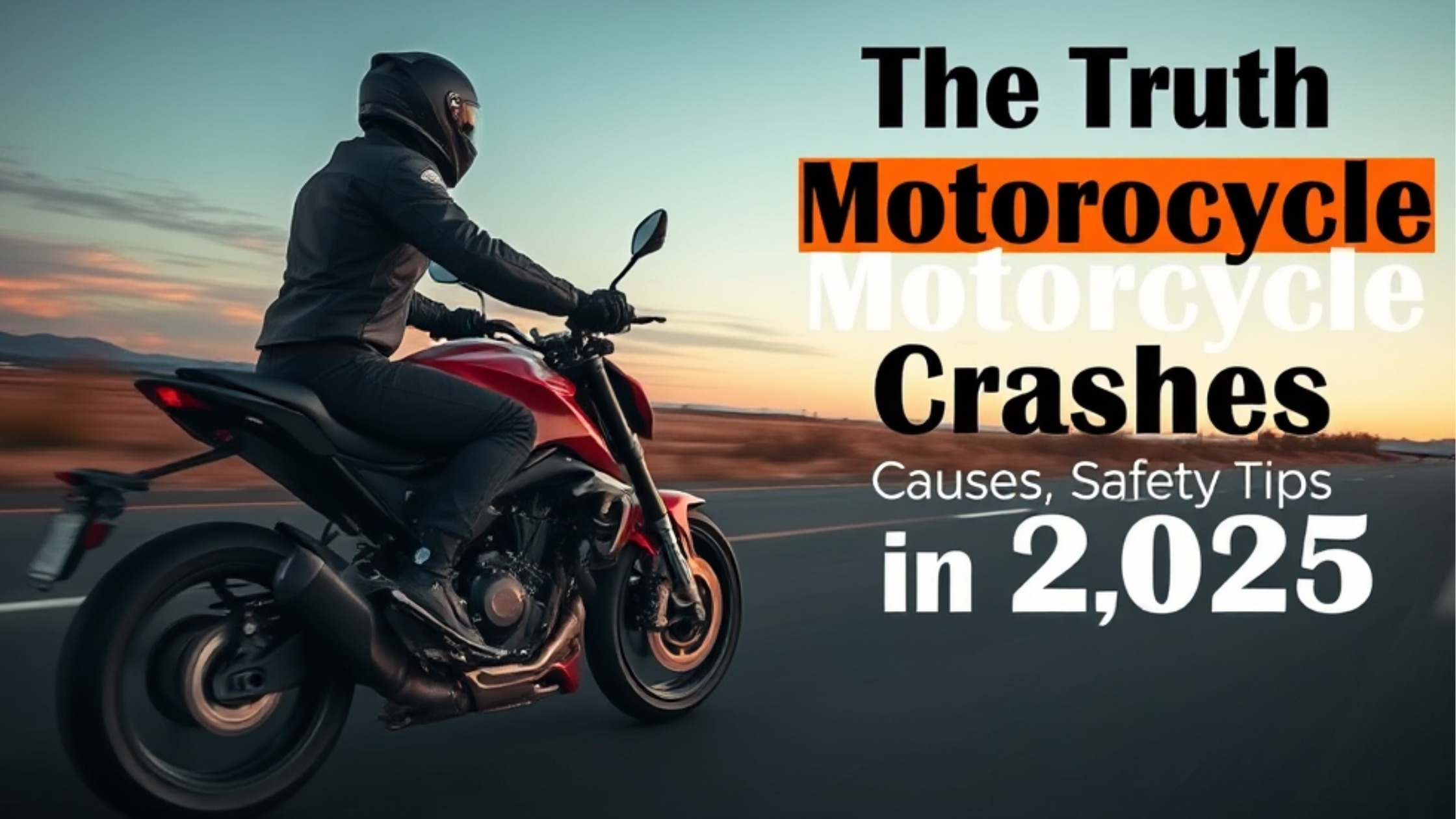Riding a motorcycle offers a unique sense of freedom and excitement, a connection to the open road that few other experiences can match. But with this thrilling freedom comes a serious responsibility: safety. In 2025, as technology advances and our roads evolve, understanding the realities of motor cycle crashes is more important than ever. This article will dive deep into the common causes of these incidents, explore cutting-edge safety technologies, and provide essential tips for both riders and other drivers to make our roads safer for everyone. Our goal is to equip you with the knowledge to ride smart, stay safe, and enjoy the ride. 🏍️💨
Key Takeaways
- Most crashes involve other vehicles: A large number of motor cycle crashes happen because car drivers don’t see motorcycles or make mistakes like turning in front of them.
- Rider skill and awareness are crucial: Proper training, defensive riding, and staying alert can prevent many accidents caused by rider error or road hazards.
- Advanced tech boosts safety: Modern motor cycles come with features like ABS, traction control, and even radar systems that significantly improve rider safety.
- Gear is your best defense: Wearing a high-quality helmet, armored jacket, pants, gloves, and boots can greatly reduce injuries in a crash.
- Road sharing is a shared responsibility: Both motorcyclists and other drivers must practice awareness, patience, and respect to keep everyone safe on the road.
The Current State of Motorcycle Safety in 2025
Motorcycling continues to grow in popularity, with more enthusiasts hitting the pavement each year. In 2025, we see a mix of traditional riding alongside rapidly evolving technology. While the thrill of the ride remains constant, the landscape of safety is changing. Bike manufacturers are integrating advanced rider aids, and riders themselves are becoming more aware of the importance of continuous training. However, the core challenges, especially involving other vehicles, persist.
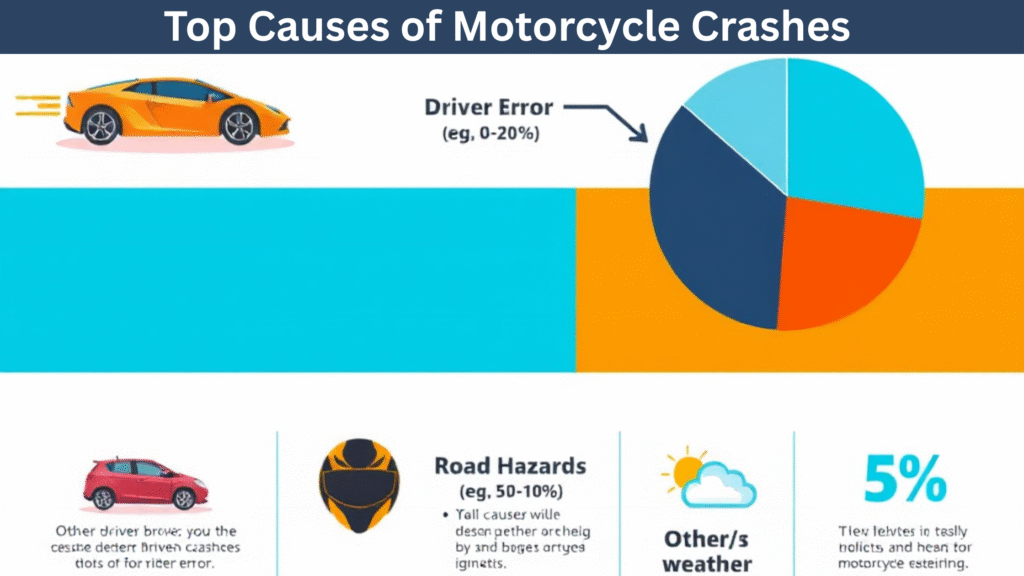
Top Causes of Motor cycle Crashes in 2025
Understanding why motor cycle crashes happen is the first step toward preventing them. While every accident is unique, patterns emerge that point to common causes.
1. Driver Error (Other Vehicles) 🚗❌🏍️
This remains the leading cause of motor cycle crashes. Car drivers often fail to see motorcycles, misjudge their speed or distance, or simply don’t look carefully enough.
- “Looked But Failed to See” (LBFTS): This is incredibly common. A driver might glance in a motorcycle’s direction but their brain doesn’t register the bike, often due to the motorcycle’s smaller size or a busy visual environment.
- Left-Turn Accidents: A car turning left at an intersection directly into the path of an oncoming motorcycle is a frequent and often deadly scenario. Drivers misjudge the motorcycle’s speed or simply don’t see it.
- Lane Changes: Drivers changing lanes without checking their blind spots, or not seeing a motorcycle already in the lane, can force a rider off the road or into a collision.
- Distracted Driving: Texting, talking on the phone, eating, or being lost in thought takes a driver’s attention away from the road, making them even less likely to spot a motorcycle.
“Many drivers just don’t register motorcycles. It’s not always intentional, but the consequences can be devastating.”
2. Rider Error 🏍️⚠️
While external factors play a big role, riders themselves can contribute to accidents.
- Excessive Speed: Riding too fast for conditions (weather, traffic, road curves) reduces a rider’s reaction time and ability to avoid hazards.
- Improper Cornering/Turning: Misjudging a turn’s radius, leaning too much or too little, or applying brakes incorrectly in a turn can lead to a loss of control.
- Following Too Closely: Not maintaining enough distance from the vehicle ahead means less time to react to sudden stops or changes in traffic flow.
- Lack of Skill/Experience: Inexperienced riders might not have the skills to handle unexpected situations, especially in emergency braking or obstacle avoidance.
- Impaired Riding: Riding under the influence of alcohol or drugs severely impairs judgment, coordination, and reaction time.
3. Road Hazards 🚧🛣️
Motorcycles are more sensitive to road surface conditions than cars.
- Potholes and Uneven Surfaces: Can cause a rider to lose control or crash, especially at speed.
- Gravel, Sand, or Debris: Loose materials on the road reduce tire grip, leading to slides or falls.
- Slippery Surfaces: Wet leaves, oil spills, ice, or metal grates can be extremely hazardous.
- Animals: Sudden encounters with animals can force riders to make abrupt maneuvers.
4. Weather Conditions 🌧️💨
Poor weather significantly increases the risk of motor cycle crashes.
- Rain: Reduces visibility and tire grip.
- Strong Winds: Can destabilize a motorcycle, especially larger bikes or those with fairings.
- Ice/Snow: Makes riding incredibly dangerous due to zero traction.
5. Motorcycle Malfunction 🔧
Though less common with modern, well-maintained bikes, mechanical failures can occur.
- Tire Blowouts: Can lead to immediate loss of control.
- Brake Failure: Loss of stopping power is obviously critical.
- Steering Issues: Loose components or damage can affect handling.
Understanding the Data: Statistics and Trends in 2025
While specific 2025 data is still being compiled, we can project trends based on previous years and emerging technologies. The overall picture suggests that while fatalities per registered motorcycle have seen some improvements due to better gear and tech, the sheer number of motor cycle crashes remains a concern due to increasing ridership and ongoing issues with driver awareness.
Here’s a look at hypothetical trends you might see in 2025:
| Category | 2020 Trend (Baseline) | 2025 Projected Trend | Impact |
|---|---|---|---|
| Fatalities per 10,000 Bikes | Steady/Slight Decrease | Slight Decrease | Improved safety tech, better rider training, but still high. |
| Crashes Involving Other Vehicles | Very High | Remains High | Driver distraction & “looked but failed to see” persist as issues. |
| Crashes Due to Rider Error | Moderate | Moderate Decrease | More advanced rider aids (ABS, TC) help mitigate rider mistakes. |
| Injury Severity | Serious | Moderate Decrease | Better protective gear and airbag systems reduce severe injuries. |
| Technology Adoption | Growing | High | ABS, traction control, stability control becoming standard. |
- Fatalities: While the number of overall crashes might fluctuate, the rate of fatalities per registered motorcycle has shown a gradual decline due to better safety gear, improved motorcycle design, and increased awareness campaigns. However, motorcycles still have a significantly higher fatality rate per mile traveled compared to cars.
- Most Common Crash Type: Intersection collisions involving another vehicle turning left in front of a motorcycle continue to be a dominant factor in serious motor cycle crashes.
- Injury Types: Head injuries have significantly decreased thanks to helmet laws and advancements in helmet technology. However, leg and arm injuries remain common.
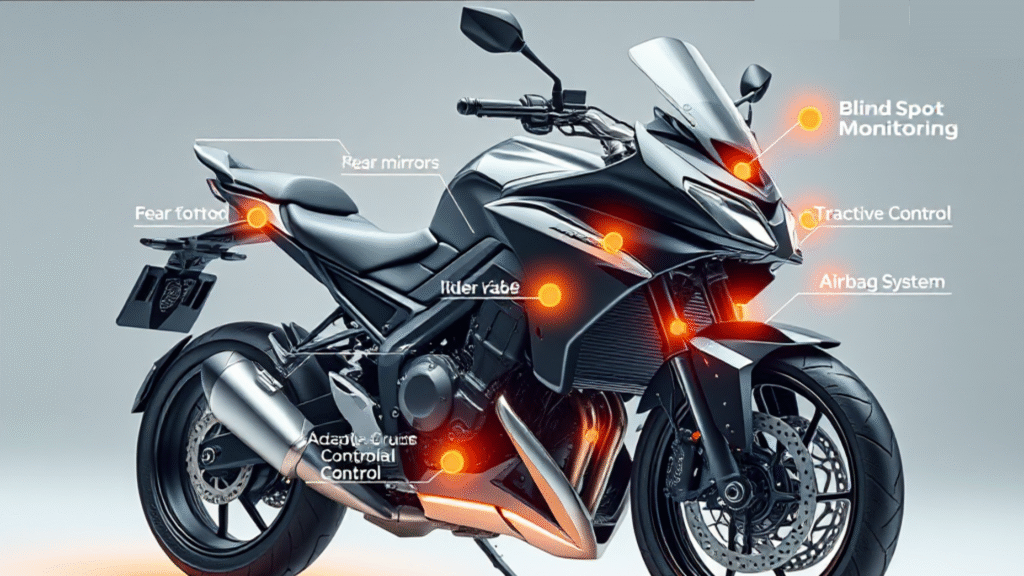
Advanced Safety Technologies for Motorcycles in 2025
Motorcycle manufacturers are constantly pushing the boundaries of safety. Modern bikes are equipped with incredible technologies that act as guardian angels for riders.
- ABS (Anti-lock Braking System): Prevents wheels from locking up during hard braking, allowing the rider to maintain steering control. This is a game-changer, especially on slippery surfaces.
- Traction Control (TC): Prevents the rear wheel from spinning excessively during acceleration, especially on loose or wet surfaces, reducing the risk of a high-side crash.
- Cornering ABS/TC: Uses an Inertial Measurement Unit (IMU) to understand the bike’s lean angle and adjust ABS and TC intervention accordingly, allowing safer braking and acceleration mid-corner.
- Stability Control/Wheelie Control: Prevents unintentional wheelies or stoppies (rear wheel lifting during hard braking), keeping the bike stable.
- Blind Spot Monitoring (BSM): Uses radar sensors to detect vehicles in the rider’s blind spots and alerts them, often with a light in the mirror.
- Adaptive Cruise Control (ACC): Automatically adjusts speed to maintain a safe distance from the vehicle ahead, reducing rider fatigue.
- Forward Collision Warning (FCW): Alerts the rider if they are approaching a vehicle too quickly, giving them time to react.
- Connected Vehicle Technology (V2V/V2I): Allows motorcycles to communicate with other vehicles (Vehicle-to-Vehicle) and road infrastructure (Vehicle-to-Infrastructure) to warn of hazards, traffic, or approaching vehicles at intersections.
- Airbag Systems: Integrated into jackets or vests, these inflate in milliseconds upon impact to provide crucial protection for the torso and neck.
These technologies don’t replace rider skill but act as powerful safety nets, helping to prevent accidents and reduce injury severity when they do occur.

Essential Safety Gear for Riders 🛡️
Your gear is your first and best line of defense in a motor cycle crashes. It’s not just about looking cool; it’s about protection.
Here’s what every rider should wear:
- Helmet (DOT & Snell/ECE Approved): This is non-negotiable. A full-face helmet offers the most protection for your head and face. Always ensure it meets safety standards like DOT (Department of Transportation) and preferably Snell or ECE (European Economic Commission).
- Armored Jacket: Made from abrasion-resistant materials (like leather or textile with Kevlar/Cordura) and includes CE-approved armor at the shoulders, elbows, and back.
- Armored Pants: Similar to jackets, these should be abrasion-resistant and have CE-approved armor at the hips and knees. Jeans offer virtually no protection in a slide.
- Gloves: Full-fingered gloves made of leather or textile with reinforced palms and knuckle protection. Your hands are often the first thing to hit the ground.
- Boots: Over-the-ankle boots designed for motorcycling, with good ankle support, oil-resistant soles, and impact protection. Sneakers or casual shoes are not safe.
- High-Visibility Clothing: Bright colors (neon green, orange) and reflective materials, especially at night, make you much easier for other drivers to see.
Wearing “all the gear, all the time” (ATGATT) significantly reduces the risk of serious injury.
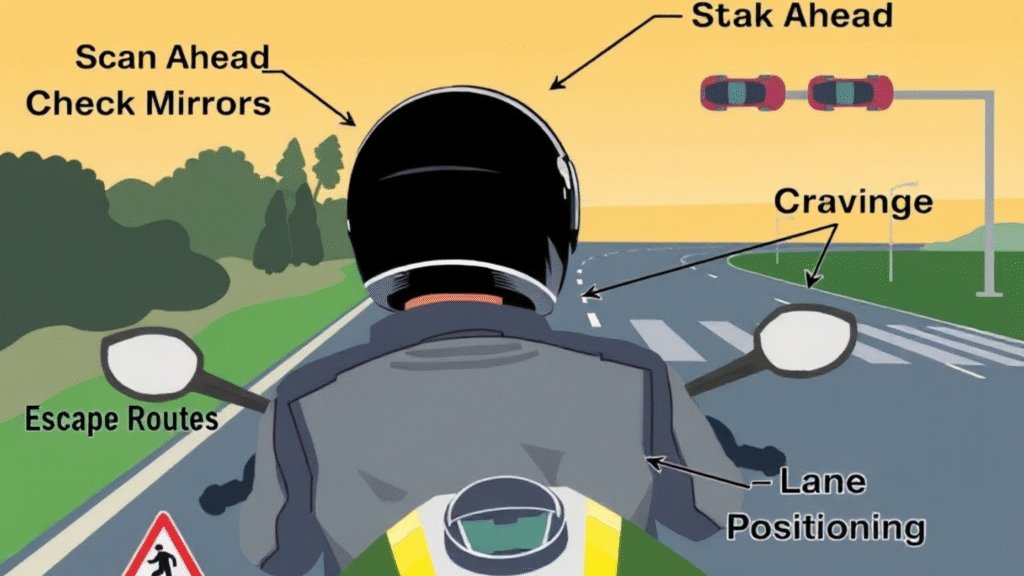
Proactive Rider Awareness and Training 🧠💡
Even with the best gear and technology, the most important safety feature is the rider themselves. Being aware, skilled, and prepared can prevent countless motor cycle crashes.
- Defensive Riding Courses: Take advanced rider training courses (like those offered by the Motorcycle Safety Foundation – MSF). These teach crucial skills like emergency braking, evasive maneuvers, and hazard perception.
- Situational Awareness: Always be scanning the road ahead, to the sides, and behind you. Anticipate potential hazards, like cars pulling out of driveways or changing lanes.
- Maintain Proper Lane Position: Ride where you are most visible to other drivers and where you have an escape route. This often means the left or right third of a lane, not directly in the middle.
- Use Your Lights: Always ride with your headlight on, even during the day. Consider adding auxiliary lights for increased visibility.
- Signal Clearly and Early: Give other drivers plenty of time to react to your intentions.
- Ride Sober: Never ride under the influence of alcohol or drugs.
- Regular Motorcycle Maintenance: Ensure your tires, brakes, lights, chain, and fluids are always in top condition. A well-maintained bike is a safer bike.
- Practice Emergency Skills: Periodically practice emergency braking and swerving in a safe, open area to keep your skills sharp.
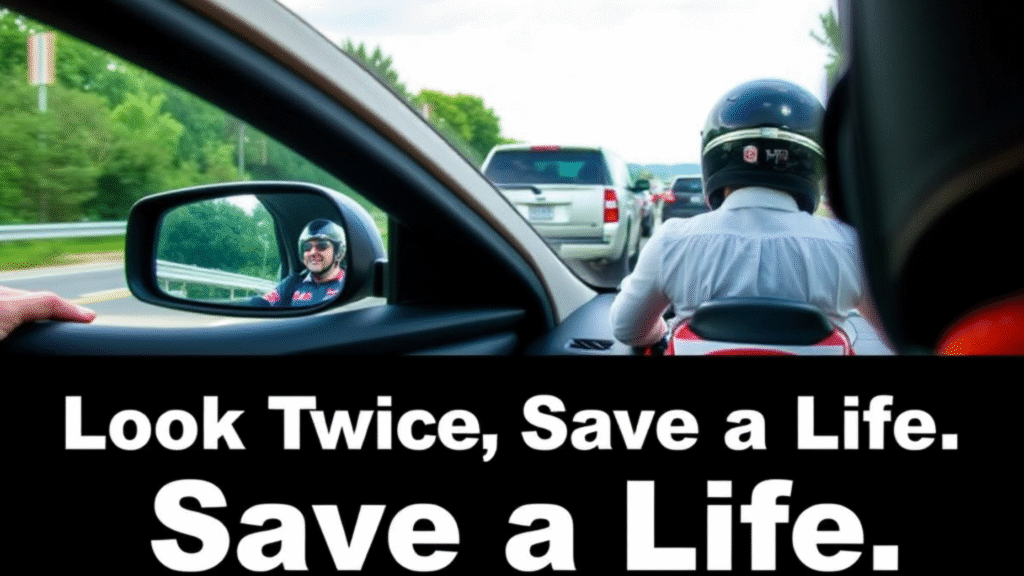
Tips for Other Drivers Sharing the Road with Motorcycles 🤝🚗
It’s a two-way street. Car drivers play a huge role in preventing motor cycle crashes.
- “Look Twice, Save a Life”: Motorcycles are small and can be easily hidden in blind spots or blend into the background. Always look twice for motorcycles, especially before turning, changing lanes, or pulling out into traffic.
- Check Blind Spots Thoroughly: Before changing lanes, always check your side mirrors and do a head check over your shoulder. Motorcycles can disappear into your blind spot.
- Give Motorcycles Space: Motorcycles need a full lane width. Do not crowd them or try to share a lane. Allow a generous following distance (at least 3-4 seconds) behind a motorcycle.
- Assume They Are Closer Than They Appear: Due to their smaller size, it’s hard to judge a motorcycle’s speed and distance. Assume they are closer and arriving faster than you think.
- Signal Your Intentions: Use your turn signals well in advance to give motorcyclists time to react to your maneuvers.
- Be Extra Cautious at Intersections: This is where many motor cycle crashes occur. Be especially vigilant when turning left.
- Don’t Drive Distracted: Put away your phone, focus on the road, and pay attention to all vehicles around you, including motorcycles.
The Role of Infrastructure and Road Design 🏗️🛣️
While individual responsibility is key, the roads themselves play a part in safety.
- Well-Maintained Roads: Smooth surfaces, free of potholes and debris, reduce the risk of loss of control.
- Motorcycle-Friendly Barriers: Guardrails designed to prevent riders from sliding underneath them after a crash can save lives.
- Clear Signage and Markings: Well-marked lanes and clear warning signs help all drivers navigate safely.
- Safe Road Surface Materials: Avoiding slippery materials (like certain types of metal grates or painted lines) in high-risk areas.
Governments and road authorities have a role in ensuring our infrastructure supports the safety of all road users, including motorcyclists.
Legal and Regulatory Landscape in 2025
Laws and regulations are in place to promote safety. In 2025, these might include:
- Helmet Laws: Most states and countries have helmet laws, varying from universal (all riders, all ages) to partial (specific age groups). Universal helmet laws are proven to save lives.
- Licensing Requirements: Strict licensing processes ensure riders have the necessary skills and knowledge before hitting the road.
- Advanced Technology Mandates: Some regions might consider mandating certain safety technologies (like ABS) on new motorcycles, similar to how they are standard on cars.
- Distracted Driving Laws: Stricter enforcement of distracted driving laws for car drivers indirectly benefits motorcyclists by making roads safer.
These regulations, combined with public awareness campaigns, form a crucial part of the overall safety strategy.
Conclusion
Understanding the truth about motor cycle crashes in 2025 means acknowledging a mix of persistent challenges and promising advancements. While car drivers’ failure to see motorcycles remains a significant factor, rider awareness, skill, and the embrace of cutting-edge safety technologies are making a tangible difference.
Motorcycling is a passion, a lifestyle, and a fantastic way to experience the world. By taking personal responsibility, staying informed about safety advancements, and actively promoting awareness among all road users, we can significantly reduce the risks. Whether you ride or drive, remember that safety on the road is a shared responsibility. Let’s all commit to looking out for each other, making every journey a safe one. Ride safe, live free! 🌟
